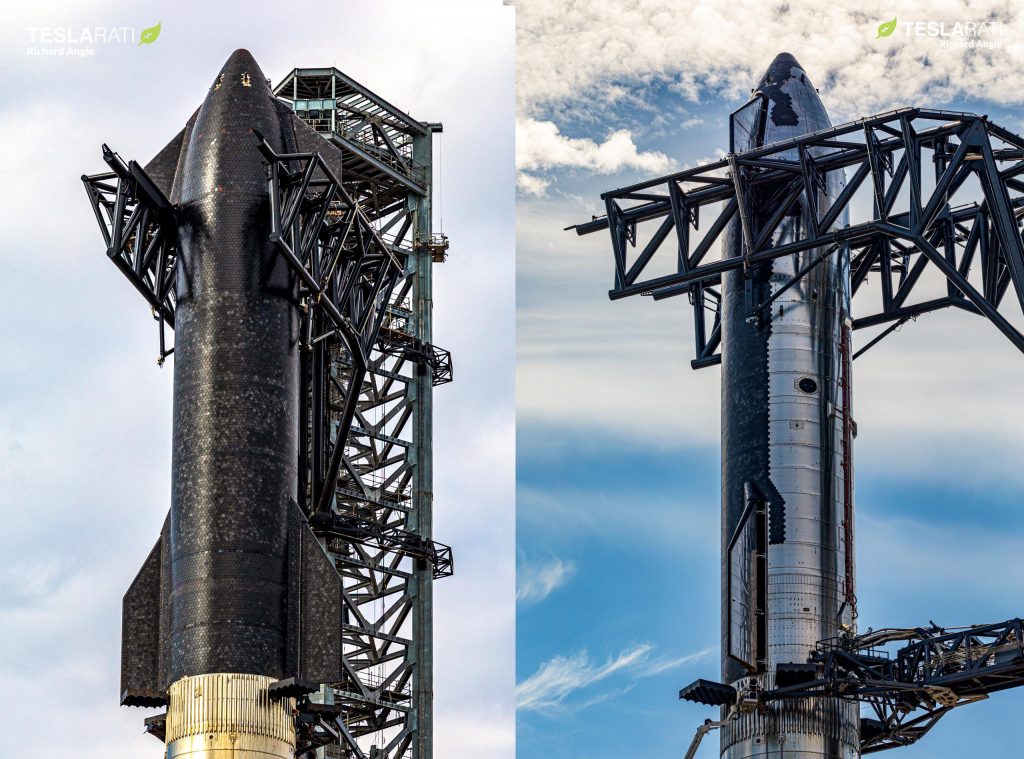On February 14th, a bit less than four days after the giant rocket was used as a backdrop for CEO Elon Musk’s first Starship presentation in years, SpaceX lifted Starship off of the Super Heavy booster and lowered the upper stage to the ground.
In early August 2021, the same pair – Booster 4 and Ship 20 – were stacked for the first time for what was described as a fit test. After briefly forming the largest rocket ever assembled, the stages were ‘destacked’ about an hour later and would ultimately return to the Starbase factory for finishing touches. Six months, one ship cryoproof, three booster cryoproofs, and three ship static fire tests later, Ship 20 and Booster 4 were once stacked to form a massive 119-meter-tall (390 ft) tall rocket
This time around, Starship S20 was stacked on top of Super Heavy B4 not with a giant crane but with a ‘launch and integration tower’ that had been outfitted with three giant arms in the interim. The tower’s main pair of arms – ‘chopsticks’ – lifted the ~100-ton (~220,000 lb) Starship almost 100 meters off the ground, swung it over Super Heavy, and then carefully lowered the stages until Super Heavy was able to latch on.
On its first true demonstration, the complex process went far smoother than anyone outside of SpaceX expected, taking the tower just four or so hours from the start of the lift to hard mate. On February 10th, shortly before Musk’s Starship update, SpaceX even opened the ‘chopsticks’ to their full breadth, leaving all of Starship S20’s weight on Super Heavy B4 and also demonstrating what the pad will likely look like moments before the first orbital Starship launch.
On February 14th, after about four days fully stacked, the tower arms reattached to Ship 20, detached from Super Heavy, and lowered the Starship back to the ground, where it was eventually installed on a transport stand. Later that night and early the next day, SpaceX then moved the ship to a small concrete pad adjacent to the launch tower that’s believed to be meant for cryogenic proof testing. It’s unclear why SpaceX didn’t tested the fully stacked Starship given that both ship and booster have already completed multiple cryogenic proof tests (or wet dress rehearsals with real propellant) over the last few months.


It’s also unclear what more SpaceX can gain from testing Ship 20 on the ground, short of full-stack operations. On Sunday, February 13th, SpaceX did, however, begin filling the orbital launch site’s fuel tanks with liquid methane (LCH4) for the first time. It’s possible that instead of using Ship 20 to test any aspect of the relatively ancient Starship prototype, SpaceX will use Ship 20 to test the orbital tank farm – particularly the fuel side of the farm, which has yet to be tested. Perhaps after testing those systems on the ground, SpaceX will re-stack Ship 20 and Booster 4 and perform a similar wet dress rehearsal to test the tower’s plumbing, the ship-fueling arm, and the overall structural integrity of the fully-stacked rocket.
SpaceX has test windows tentatively scheduled on February 16th, 17th, and 18th.


<!–
–>
